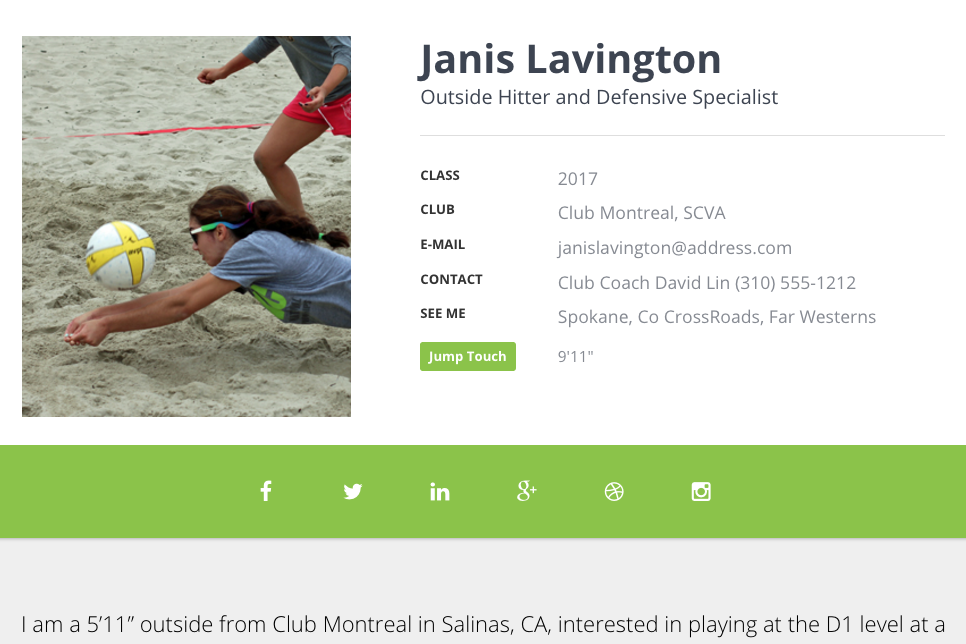The College Soccer Recruiting Process Explained
If you’re looking to play soccer in college, it’s never too early to start learning about the recruiting process. Get ahead of the game by familiarizing yourself with the steps involved in the NCAA soccer recruiting process, and learn how to create an online athlete profile so that you stand out to college soccer coaches. Get started by learning the basics explained below.
Few high school soccer player have much direction when starting the recruiting process, so we have provided a set of handy links on our Free Resources page. The quicker you learn about the difference between NCAA Division 1, 2, and 3 recruiting, the less stressful the process will be, because each is governed by its unique set of rules.
Then, aside from keeping your skills up and playing the right showcase tournaments, the most important thing you can do is keep your grades up. No I'm not kidding.
The reason that grades are important is twofold. First, the "better" schools - the ones your parents want you to get into, and the ones that are more likely to improve your chances of getting a job when you get out - have strict academic requirements about the types of students they 'allow' their coaches to recruit. No matter how great of a soccer player you are, you're not getting past the Harvard or Stanford admissions offices (or similar schools) if your grades and test scores are not within their target range. The second reason is that some schools - like the Ivies and all D3 colleges do not offer athletic scholarships. They do, however, off merit-based academic scholarships for recruitable athletes. But the operative word here is "merit".
Soccer Recruiting: A Step-by-Step Guide
Initial contact from coach. The recruiting process for college soccer typically begins with a general interest email, letter, flyer, or pamphlet sent by the coach to a soccer player, or an introduction email sent from the soccer player to the coach. Coaches typically send 'marketing' emails to hundreds or thousands of athletes as a “first sweep” to assess interest among athletes at once. Although these letters are required by the NCAA to be “nonathletic recruiting materials,” they often include basic questionnaires for athletes to complete online. It's a good idea to respond and fill out each school's online questionnaire: the only problem with the school questionnaires as you will see, is that they are not updatable. Nonetheless, it's the way the school wants you to get 'in their system', so you should fill out as many as you can.
This is the time to think about developing a central online profile that you can update, since you will want to drive prospective coaches back to your website time and time again to look at your newly added film, grades, and test scores as you move through the recruiting process.
Base evaluations. Next, coaches will begin researching athletes further to assess which candidates they’re most interested in recruiting. This research is typically conducted online and/or by contacting the players’ school and club coaches, since NCAA rules won’t allow coaches to make direct contact with players until the players’ junior years. The coach will search online for additional information about an athlete, such as his/her academic portfolio, test scores, GPA, game statistics, and performance records. The soccer coach will also start reviewing video footage and examining the athlete’s specific strengths and weaknesses. At this point, a soccer coach might begin drafting a short list of recruits to pursue further.
Personal contact. During a soccer player’s junior year, a college coach may initiate personal contact with the player over the phone or in person (on campus). The coach may also come watch the athlete play in a soccer game. At this point, the college soccer coach begins to get a better “feel” for the athlete and can better assess things like character and attitude.
Campus visit. Next, the top soccer recruits will most likely be invited for an official visit to the school campus to meet the team and get a better feel for the soccer program. Note that official visits are not allowed until a player’s senior year and there are a limited amount of official visits an athlete can make to one Division I school, according to NCAA guidelines. If the campus visit goes well, the next step in the process is usually the extension of an offer.
Unique Features of the Soccer Recruiting Process
The men’s and women’s college soccer recruitment process in the U.S. is competitive, so it’s crucial that athletes do everything they can to help themselves stand out to coaches during the recruiting process. Specific features of the soccer recruitment process that make it unique among other sports include:
- Initial contact: The NCAA allows limited contact between coaches and high school soccer players during athletes’ sophomore years. High school soccer players are allowed to receive documents like brochures, camp invites, and questionnaires from college coaches, but coaches are not allowed to initiate personal contact until the following academic year. However, athletes are allowed to initiate contact with coaches. View the NCAA’s college-bound athlete guide for more information, including contact rules and timelines according to specific division levels.
- Recruitment periods: Heavy recruitment for men’s and women’s Division I college soccer begins on September 1st of junior year, at which point coaches are able to initiate contact with players and players are allowed to make “unofficial” visits to schools.
- “Equivalency” status: Division I men’s and women’s soccer are considered “equivalency” sports by the NCAA, meaning that coaches have flexibility in roster size and scholarship amount given to each player. Whereas the NCAA guidelines for “head count” sports only allow coaches to offer full scholarships, coaches in equivalency sports are allowed to offer partial scholarships to players. Division I men’s soccer coaches are allowed 9.9 scholarships; Division I women’s soccer coaches are granted 14.
- Female sport: The NCAA has supported women’s soccer since 1982, and it’s one of the most highly sponsored sports for NCAA member schools. For more information about women’s participation in NCAA college athletics, view the NCAA Women’s Sports Inventory and Title IX resource center.
- Commitments: The signing period for Division I soccer players is from February through August of an athlete’s senior year. During this time, soccer players sign a letter of intent stating which university program they plan on attending.
Why Do Soccer Players Benefit From an Online Profile?
For team sports like soccer, the recruiting process can be somewhat subjective because met
Recruiting agencies. Because college soccer recruitment can be overwhelming for athletes, parents, and coaches, many athletic recruiting agencies exist to help with the process.
The success levels and value of these agencies is unclear -- although they do reduce the burden of the recruitment process on the athlete and his/her family, recruitment agencies can sometimes overlook individual or personal strengths of an athlete since they handle so many athletes at once. Also, note that not all coaches use recruitment services: some coaches say that they “trust [agencies’] judgements and will take a look at the athletes sent our way,” others say that they immediately delete emails from agencies and consider them “equivalent to spam.”
With this in mind, it’s important that as a high school soccer player, you take the initiative to present yourself to coaches with an easy-to-find, up-to-date online profile. If your profile has in-depth academic and athletic information, you’ll make it easier for coaches to find, assess, and recruit you -- ultimately increasing your chances of getting recruited for a team. Your online profile should include all basic athletic and academic information and records, as well as video clips. For help setting up your own online athlete profile, contact us.
Note, also, that university coaches may not consider soccer players from smaller high schools as closely as those from larger high schools, because larger high schools simply have a higher level of competition due to their size. So, if you’re a soccer player at a small high school, it’s even more important that you create a stand-out online profile that includes everything coaches need in a single location. The objective of the profile should be to put your best foot forward and make it easy for college coaches to say “yes.”
Why Should I Include Grades and Test Scores Within My Profile?
To meet minimum GPA requirements, college soccer coaches seek out high school athletes who show potential to help their team succeed academically. For example, if a coach is considering two identical soccer players during the recruitment process and one has a higher GPA than the other, the coach will most likely choose the athlete with the higher GPA. Note that high school students must maintain a 2.3 GPA to compete during their freshman year of college for Division I sports. For more information, visit the NCAA’s 2point3.org website.
Therefore, since academic details are a key part of your online profile during the college recruitment process, in choosing an online profile tool, be sure to choose a platform that allows you to attach and post (not just state) your GPA and SAT/ACT scores. Also be sure that all of your sensitive information is password protected -- something we always ensure at Athletics Recruiting.
Conclusion
The NCAA college soccer recruiting process can be intimidating, but if you familiarize yourself with the process and create a strong online profile, you’ll be set up for success. As a high school soccer player, your skills are your most important asset -- however, your ability to package and showcase your athletic skills along with your academic information is a key part of the recruiting process. With the right online athlete profile, you have a better shot at standing out to coaches as they recruit athletes for their college soccer teams.
Our College Recruiting Websites Can Help with Your College Recruiting Process:
 |
 |
 |
